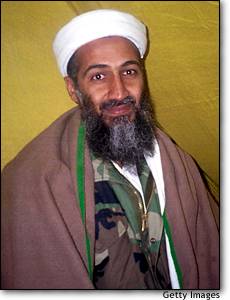
9-16-2001 - The Dream:
I was inside a prison-like place with high ceilings. There were 24 small cells in the center of this place. There were a small number of people inside each small cell. However, along the wall, there were much larger cells. There was some kind of event the people in the small cells were trying to agree on, and in one cell, a black woman was extremely angry and irate and what was going on. So, she was released and she went into the larger cell instead.
An expert on the radical leader says targeting the Saudi dissident won’t eliminate his threat
By Peter McGrath
Sept. 14 — Thomas Gouttierre is inclined to think Osama bin Laden is the godfather of the attacks in New York and Washington. At least he can’t think of anyone else. “Osama bin Laden is part of the globalized world,” says Gouttierre, the dean of international studies at the University of Nebraska at Omaha and a veteran bin Laden watcher at UNO’s Center for Afghanistan Studies. “His organization is the most globalized.” Everything about the attacks—the type of target, the extensive planning and most of all the overseas reach—suggests bin Laden’s organization, Al Qaeda (“The Base”).
MOREOVER, SAYS GOUTTIERRE, who has lived in Afghanistan for more than 10 years at different times, first as a Peace Corps volunteer, then with the United Nations peacekeeping mission to Afghanistan, where he reported on both bin Laden and the Taliban, Al Qaeda is now the most capable force among known Islamic terrorist groups.
Most others are riven by internal conflicts or else have been heavily infiltrated. Indeed, the group provides much of the military muscle now being deployed by Afghanistan’s Taliban leaders in their ceaseless civil war against the opposition forces in the northern part of the country.
But to say that bin Laden is in some sense the sponsor of the attacks isn’t to say he ordered them. “He probably didn’t know what was going to happen on Tuesday,” says Gouttierre. “He’s clever. The organization is clever, and the more decentralized the organization is, the more effective it can be. If you don’t have communications streaming back to the center, you’re less vulnerable to discovery.”
It’s in the nature of a terrorist group organized into cells that one cell doesn’t know much if anything about what other cells are doing. In the case of Al Qaeda, it’s clear that while bin Laden arranges financing for the group, sets out training methods and supplies an overall ideological framework, the terrorists are often on their own once training is over and they’ve been conveyed out of the camps in Afghanistan or Sudan. Gouttierre calls this “guerilla terrorism” because of the high degree of operational freedom the agents enjoy: “If you make the people involved not dependent on what happens to anyone else, the risk of failure is diminished considerably.”
In fact, he says, the system creates “a kind of friendly competition among cells.” There is similarity among them, but that’s because “the objectives are the same, the training is the same and therefore the methods are the same.”
For this reason, Gouttierre is skeptical about talk of attacking bin Laden directly. For one thing, he says, “removing bin Laden from the scene would have no effect on the group ... It’s all designed so that if 10 people die, it’ll probably grow, not diminish.” Many of its members are overseas already—probably more than 50 left in the United States alone, he thinks, with hundreds or even thousands in other countries—and therefore self-directed. For another, such talk is simply “anthropomorphizing the threat” and missing the point that Al Qaeda is far more than one man. But doesn’t the group depend on his reported charisma? “The issues have made him charismatic,” says Gouttierre, “and we’ve made him charismatic. Even those who abhor what he does begrudgingly admire the way he frustrates the big power.”
Then there’s the problem of how some military force would even find bin Laden. Gouttierre suspects that bin Laden is no longer at any of the known camps, but is in hiding in the mountainous border region between Afghanistan and Pakistan. Moreover, the Taliban would inevitably find it difficult to turn him over. There’s the civil war, in which “the fighting forces under Osama bin Laden are far more formidable than those the Talibs can muster at any given point.” And then there’s a political reality: the Taliban “are concerned that unless they maintain [bin Laden’s] extremist stance, they’ll lose the support of extremist Arabs.”
On the other hand, the Taliban are well aware that Western forces could hold them responsible as accessories, in effect, and bring devastation to a country that has suffered nothing but misery for nearly three decades. In short, says Gouttierre, “If I were a Talib right now, I’d be thinking I’m between the devil and the deep blue sea. They might be trying to play for time. The Pakistanis may try to influence them, but they’re in a quandary, too. There are a lot of people there who also look to bin Laden.” Still, the best hope for a resolution appears to involve Pakistan, Gouttierre says. If the Pakistani military were dispatched to seize bin Laden, they would at least find it easy to operate in Afghanistan, simply through greater familiarity with the terrain and greater experience with local conditions. “They could get into Afghanistan easily.” And they could probably get out—at least more easily than the United States could.